24 Birds of Prey in Utah
Utah, with its diverse landscapes ranging from mountains to deserts, is home to a rich variety of birds of prey. Here are 24 species that can be found in Utah:
1. Great Horned Owl (Bubo virginianus)
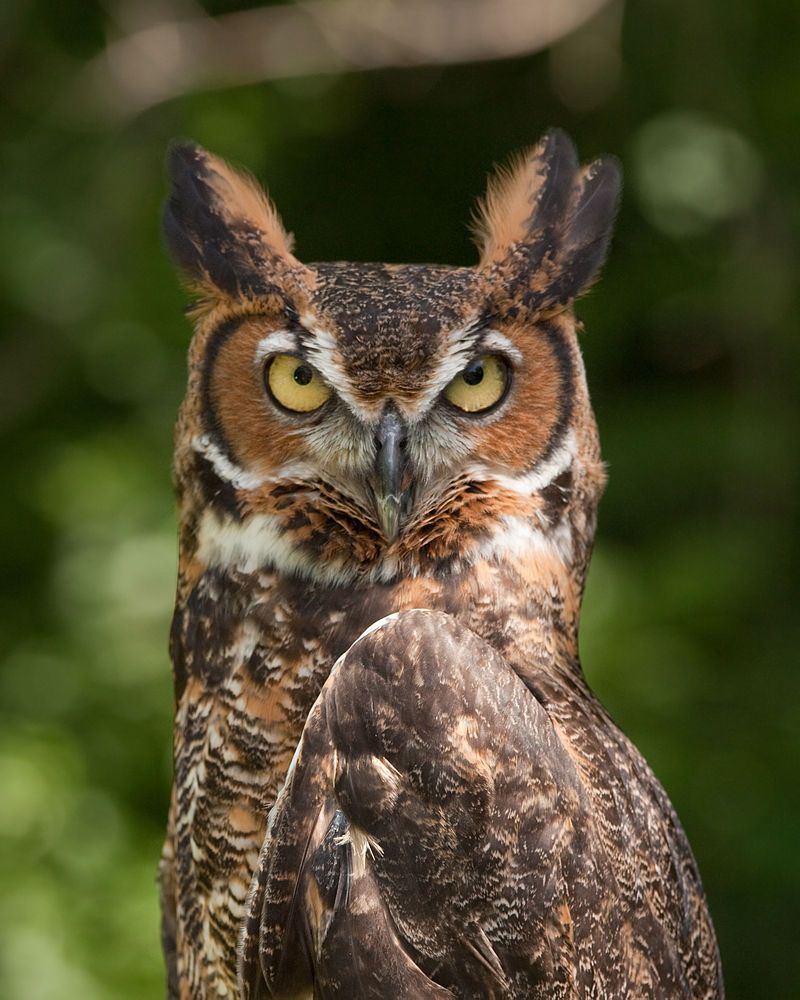
The Great Horned Owl, Bubo virginianus, is a prominent bird of prey in the Americas. This species is notable for its intimidating yellow-eyed gaze and earlike tufts. Adapted for nocturnal hunting, it has exceptional hearing and silent flight.
Their diet is diverse, preying on mammals, birds, and reptiles. They typically nest in trees, cliffs, or sometimes in abandoned nests of other large birds.
Recognized for their deep hooting call, they play a crucial role in local ecosystems as apex predators. Their plumage varies regionally from sooty to pale.
This owl’s adaptability to various habitats, including urban areas, underscores its resilience and ecological significance.
| Kingdom | Animalia |
| Phylum | Chordata |
| Clade | Dinosauria |
| Class | Aves |
| Order | Strigiformes |
| Family | Strigidae |
| Genus | Bubo |
| Species | B. virginianus |
2. Bald Eagle (Haliaeetus leucocephalus)
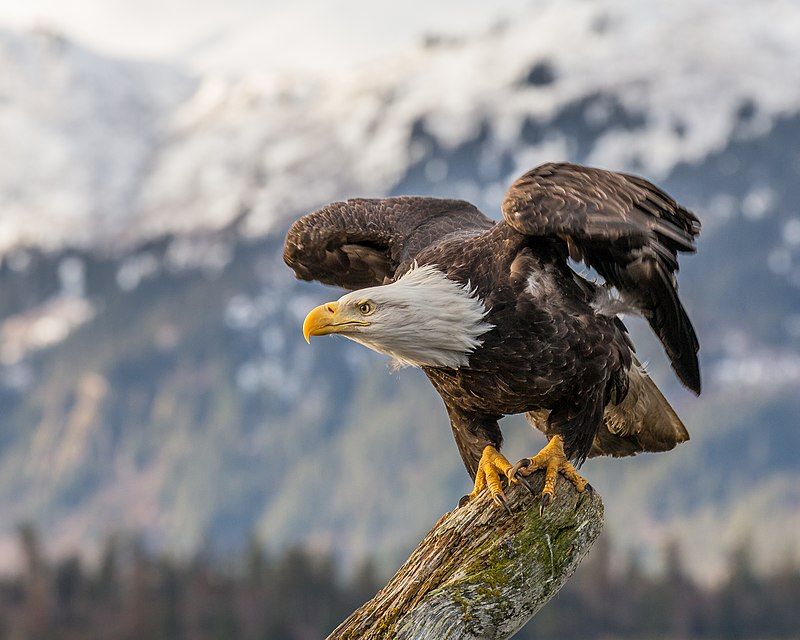
The Bald Eagle, Haliaeetus leucocephalus, is an iconic North American bird and the national symbol of the United States. Adults are known for their white heads and tails, which contrast with their dark brown bodies and wings, and their regal appearance.
They are primarily fish-eaters, often seen near lakes, rivers, and coasts. Bald Eagles build enormous nests in large trees, cliffs, or human structures, sometimes weighing over a ton.
Their recovery from near extinction due to DDT pollution is a conservation success story. Migratory in colder regions, they showcase remarkable hunting and flying skills.
This species plays a vital role in cultural and natural heritage, symbolizing strength and freedom.
| Kingdom | Animalia |
| Phylum | Chordata |
| Clade | Dinosauria |
| Class | Aves |
| Order | Accipitriformes |
| Family | Accipitridae |
| Genus | Haliaeetus |
| Species | H. leucocephalus |
3. Red-tailed Hawk (Buteo jamaicensis)
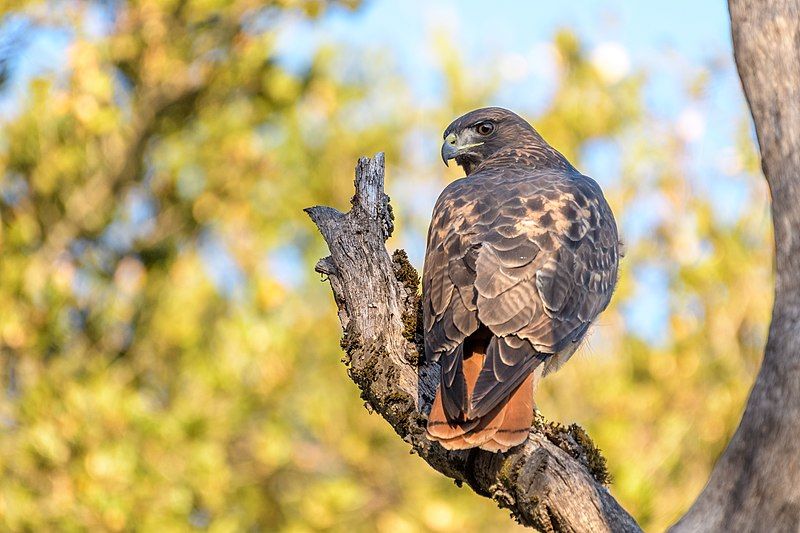
The Red-tailed Hawk, Buteo jamaicensis, is among North America’s most widespread and adaptable raptors.
Easily recognized by its broad, rounded wings and short, wide tail typically showing a rich reddish-brown hue, this bird is a familiar sight soaring above open fields.
They feed on small mammals, birds, and reptiles, often seen perched along highways or soaring in thermals. These hawks prefer open areas with high perches for hunting and nesting.
Vocal birds and their piercing cry is often used in movies to depict any eagle or hawk. Their adaptability to diverse habitats, including urban areas, has made them a common yet remarkable sight.
| Kingdom | Animalia |
| Phylum | Chordata |
| Clade | Dinosauria |
| Class | Aves |
| Order | Accipitriformes |
| Family | Accipitridae |
| Genus | Buteo |
| Species | B. jamaicensis |
4. American Kestrel (Falco sparverius)
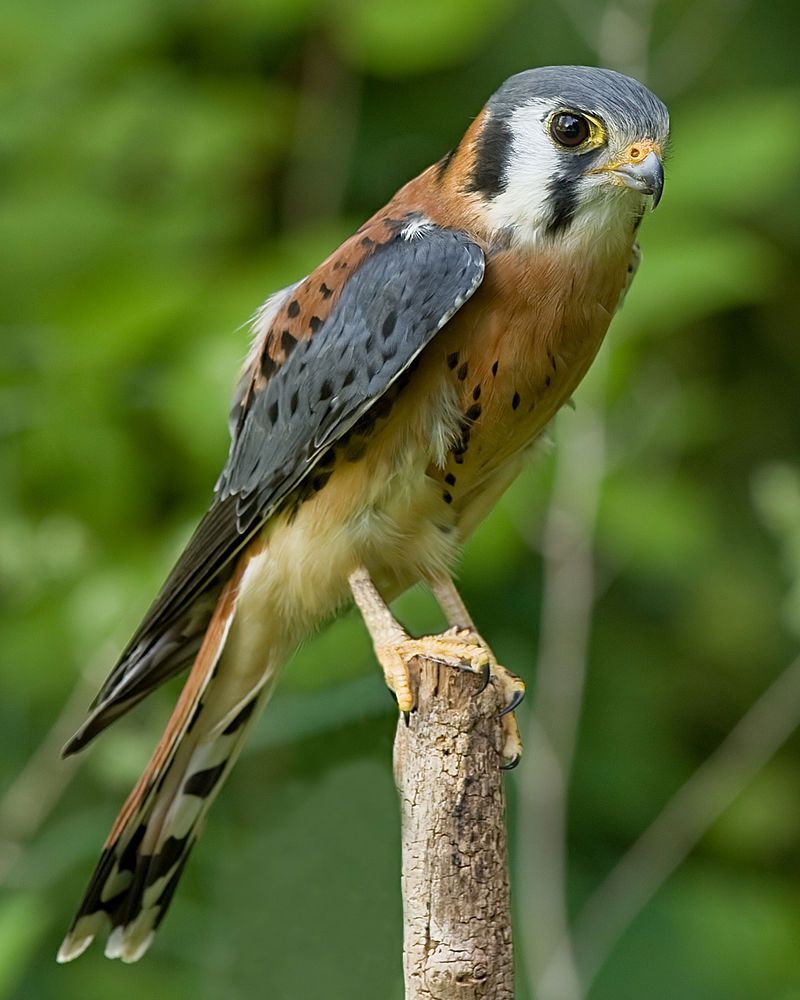
The American Kestrel, Falco sparverius, is North America’s smallest and most colorful falcon. This bird exhibits sexual dimorphism, with males having blue-grey wings and females having brown wings.
They are known for their hunting technique of hovering in the air before diving to catch prey, which includes insects, small mammals, and birds. Kestrels are often seen in open habitats like fields and meadows.
They nest in cavities, often utilizing man-made structures. Their presence in urban areas helps control rodent and insect populations.
Their vibrant plumage, agility in flight, and approachability make them a favorite among birdwatchers and a symbol of the delicate balance in ecosystems.
| Kingdom | Animalia |
| Phylum | Chordata |
| Clade | Dinosauria |
| Class | Aves |
| Order | Falconiformes |
| Family | Falconidae |
| Genus | Falco |
| Species | F. sparverius |
5. Golden Eagle (Aquila chrysaetos)
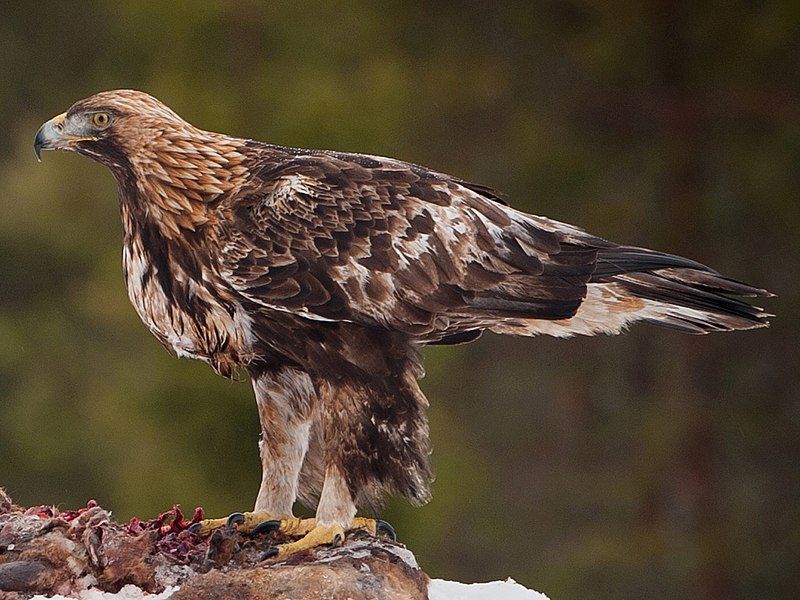
The Golden Eagle, Aquila Chrysaetos, is one of the best-known birds of prey in the Northern Hemisphere. Majestic in appearance, they have dark brown plumage with lighter golden-brown nape feathers.
These powerful birds hunt a range of prey, from rabbits to marmots, and can even take down deer. They prefer open and semi-open spaces, often found in mountains and highlands.
Golden Eagles are monogamous and build large nests, which they may use for several years. Revered in many cultures, they symbolize strength and freedom.
Their solitary nature, impressive hunting skills, and wide range make them a symbol of the wilderness.
| Kingdom | Animalia |
| Phylum | Chordata |
| Clade | Dinosauria |
| Class | Aves |
| Order | Accipitriformes |
| Family | Accipitridae |
| Genus | Aquila |
| Species | A. chrysaetos |
6. Peregrine Falcon (Falco peregrinus)
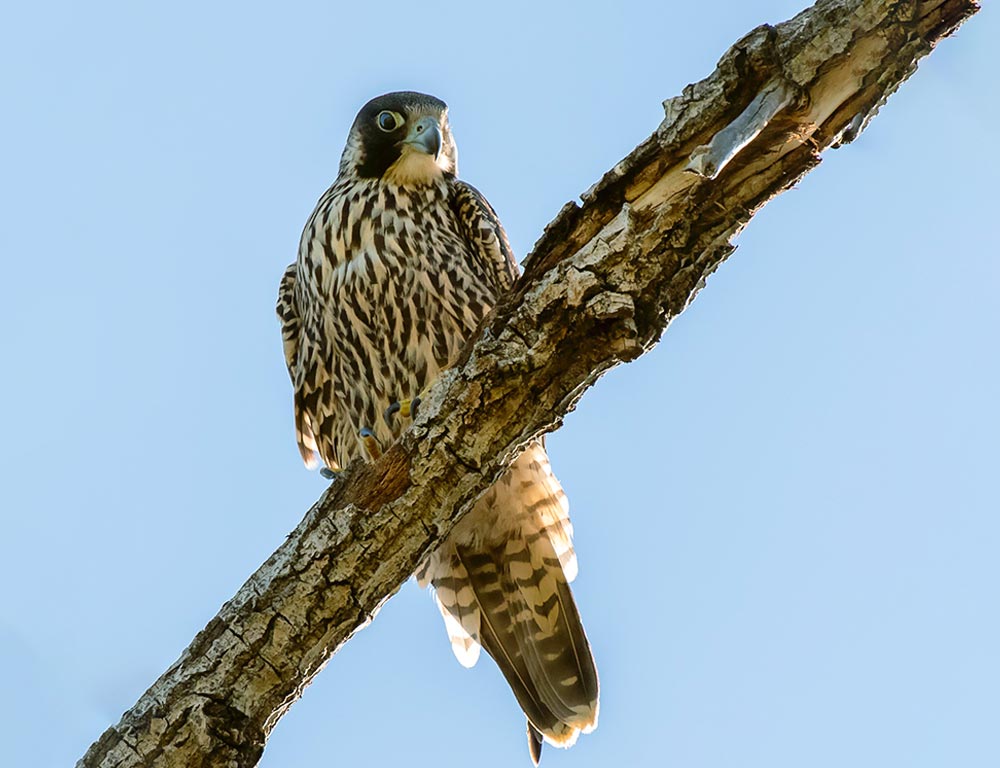
The Peregrine Falcon, Falco peregrinus, is renowned for being the fastest bird in the world, reaching speeds over 200 mph during dives. This cosmopolitan bird of prey is medium-sized with a blue-grey back, barred white underparts, and a distinctive black “moustache.”
It preys primarily on other birds caught in mid-air. Peregrines nest in various landscapes, often on high cliffs or tall buildings in urban areas.
Their recovery from the brink of extinction due to DDT exposure is a remarkable conservation success. The species is admired for its speed, agility, and hunting prowess, symbolizing the power and precision of nature.
| Kingdom | Animalia |
| Phylum | Chordata |
| Clade | Dinosauria |
| Class | Aves |
| Order | Falconiformes |
| Family | Falconidae |
| Genus | Falco |
| Species | F. peregrinus |
7. Burrowing Owl (Athene cunicularia)
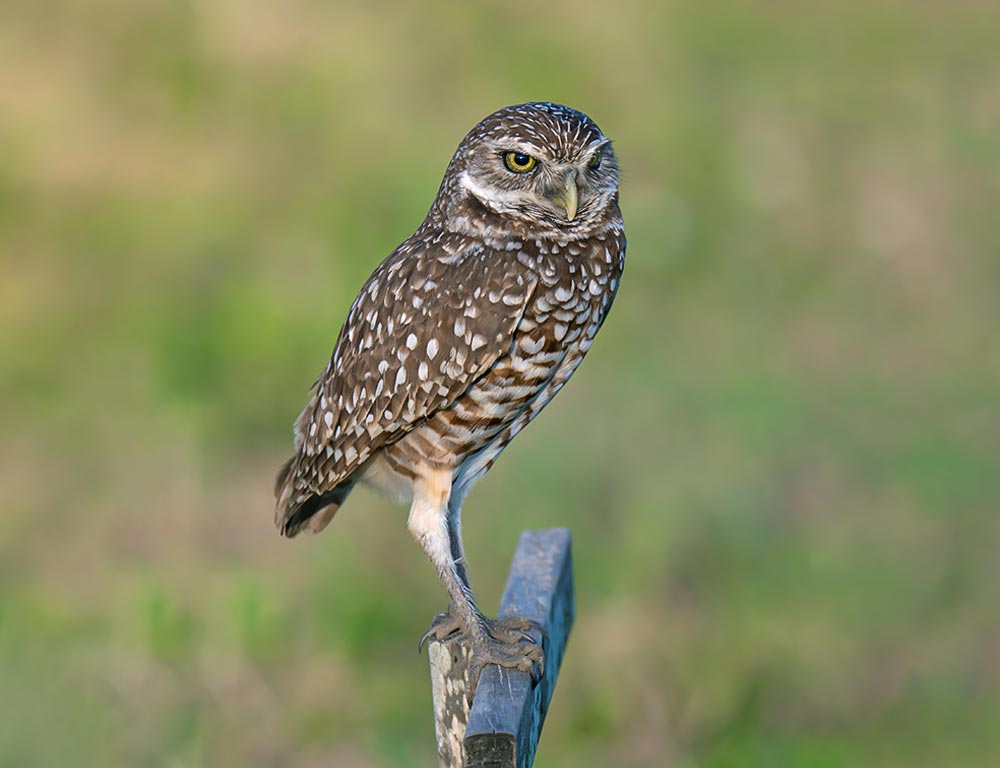
The Burrowing Owl, Athene cunicularia, is a small, long-legged owl found throughout open landscapes of North and South America. Unlike most owls, they are active during the day.
Unique for their ground-dwelling habits, they often inhabit burrows made by other animals like prairie dogs. These owls have a mottled brown and white appearance with bright yellow eyes.
Their diet includes insects, small mammals, and birds. They face threats from habitat loss and are considered a species of special concern in some areas.
Their charismatic nature and unusual habitat preferences make them a fascinating subject for birdwatchers and wildlife enthusiasts.
| Kingdom | Animalia |
| Phylum | Chordata |
| Clade | Dinosauria |
| Class | Aves |
| Order | Strigiformes |
| Family | Strigidae |
| Genus | Athene |
| Species | A. cunicularia |
8. Osprey (Pandion haliaetus)

The Osprey, Pandion haliaetus, is a large raptor, widespread and found near water bodies worldwide. It is uniquely adapted for fishing, its primary food source, with reversible outer toes and barbed pads on the feet to grip slippery fish.
Ospreys have a distinctive appearance with white underparts, dark brown upperparts, and a characteristic black stripe through the eye. They build large stick nests on structures like trees, cliffs, and man-made platforms.
The osprey’s global distribution and specialized fish-eating habits make it a unique member of the raptor family, often considered a sentinel species for monitoring the health of aquatic environments.
| Kingdom | Animalia |
| Phylum | Chordata |
| Clade | Dinosauria |
| Class | Aves |
| Order | Accipitriformes |
| Family | Pandionidae |
| Genus | Pandion |
| Species | P. haliaetus |
9. Cooper’s Hawk (Accipiter cooperii)
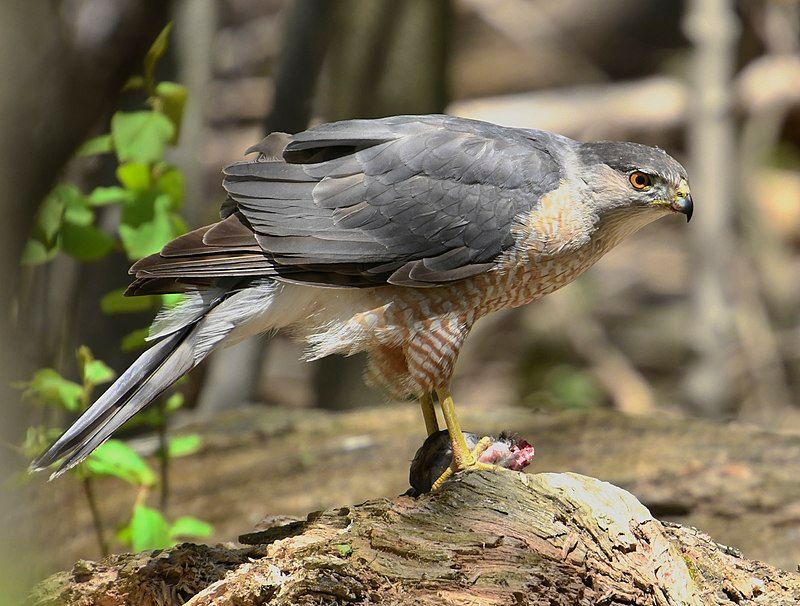
Cooper’s Hawk, Accipiter cooperii, is a medium-sized hawk common in North American forests and woodlands. Known for their agility, these hawks have short, rounded wings and a long tail, enabling them to maneuver through dense trees.
They have a blue-grey back, a reddish-barred chest, and a dark cap. Cooper’s Hawks primarily prey on birds and small mammals.
They are often seen in urban areas, hunting near bird feeders. While historically persecuted due to fear of impacts on poultry and songbirds, they have adapted well to human-altered landscapes.
Their presence in urban areas highlights the adaptability and resilience of wildlife in diverse habitats.
| Kingdom | Animalia |
| Phylum | Chordata |
| Clade | Dinosauria |
| Class | Aves |
| Order | Accipitriformes |
| Family | Accipitridae |
| Genus | Accipiter |
| Species | A. cooperii |
10. California Condor (Gymnogyps californianus)
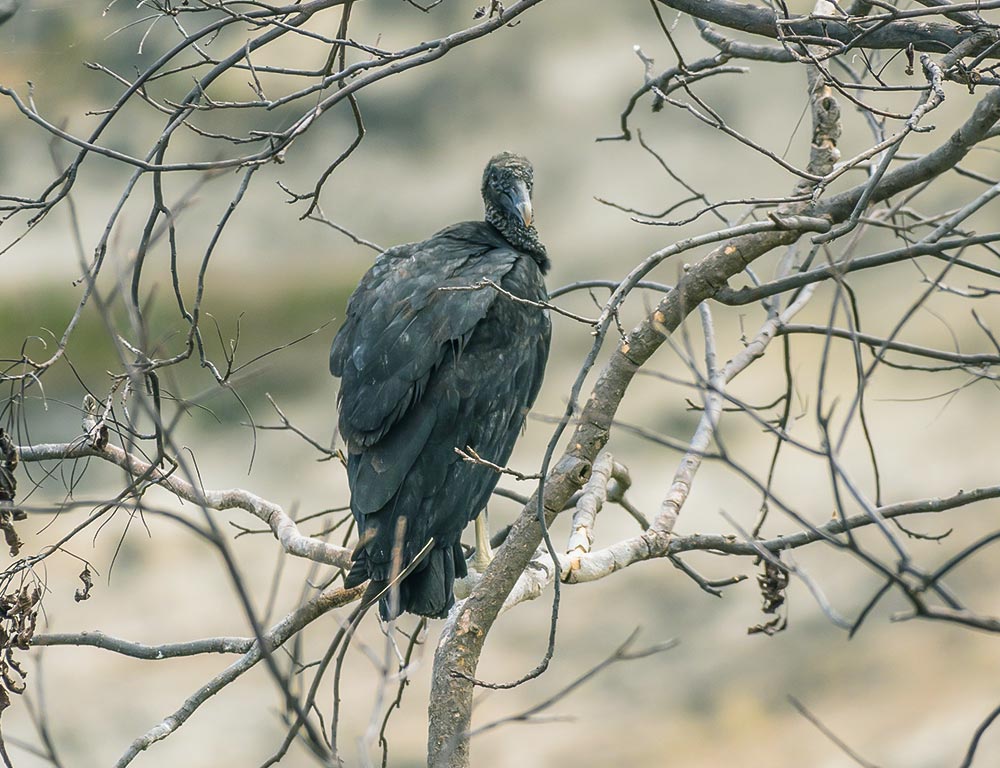
| Kingdom | Animalia |
| Phylum | Chordata |
| Clade | Dinosauria |
| Class | Aves |
| Order | Accipitriformes |
| Family | Cathartidae |
| Genus | Gymnogyps |
| Species | G. californianus |
11. Ferruginous Hawk (Buteo regalis)
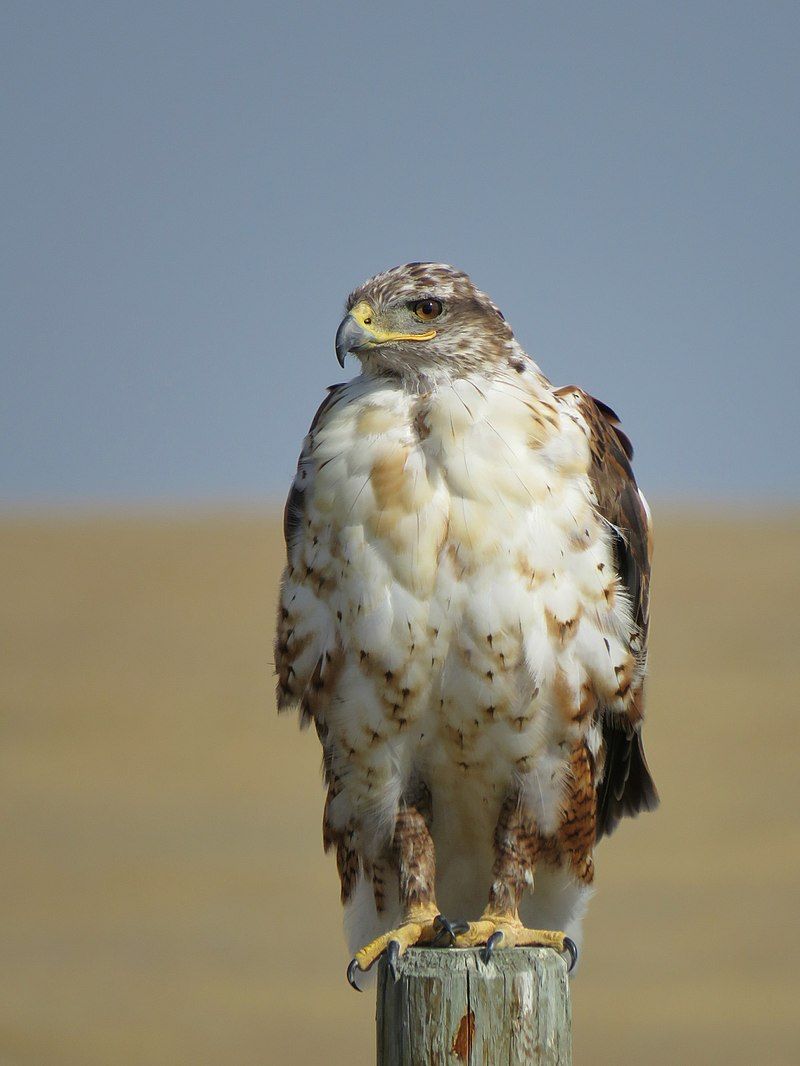
The Ferruginous Hawk, Buteo regalis, is the largest of the North American Buteo hawks. It is distinguished by its large size, wide wingspan, and a beautiful rusty hue on its back and shoulders. Inhabiting open prairies and desert regions, they are skilled hunters of small mammals and birds.
They often perch on poles or soar on thermals while hunting. These hawks are known for their spectacular courtship displays involving dramatic dives and rolls.
Their population is affected by habitat loss and rodenticide exposure. With its impressive size and striking appearance, the Ferruginous Hawk is an important symbol of the North American grassland ecosystem.
| Kingdom | Animalia |
| Phylum | Chordata |
| Clade | Dinosauria |
| Class | Aves |
| Order | Accipitriformes |
| Family | Accipitridae |
| Genus | Buteo |
| Species | B. regalis |
12. Rough-legged Buzzard (Buteo lagopus)
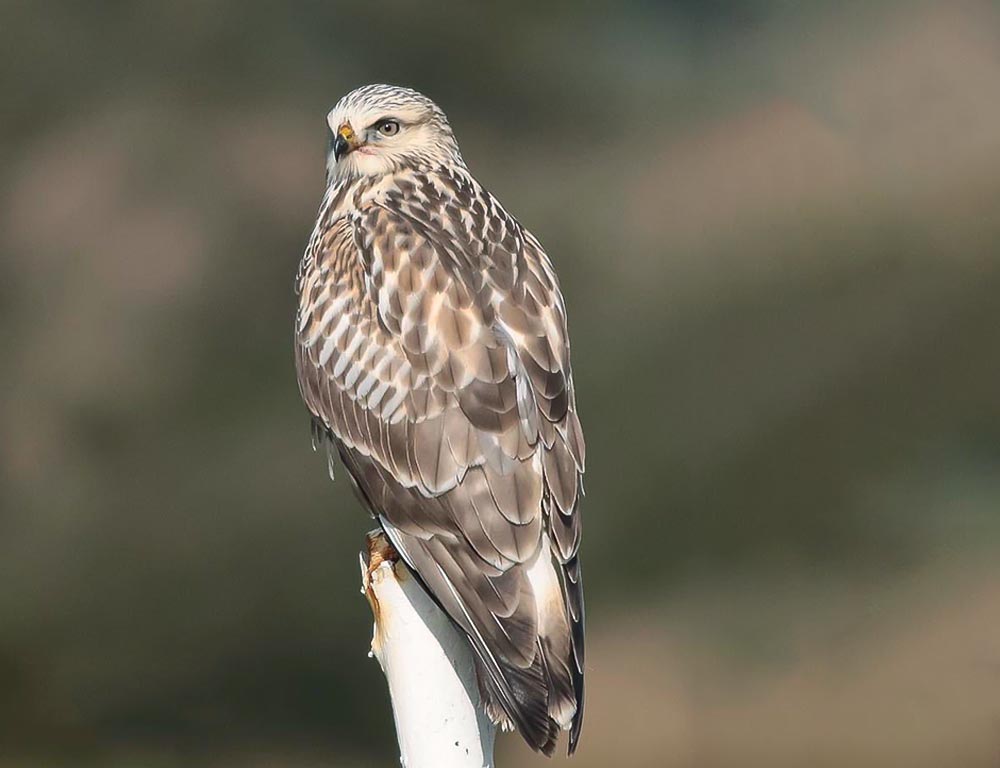
The Rough-legged Buzzard, Buteo lagopus, also known as the Rough-legged Hawk in North America, is a large raptor of the Arctic and boreal regions.
Notable for its feathered legs down to the toes, it’s adapted to cold environments. This bird exhibits a range of plumage patterns but typically has a brown back and a pale underside with dark streaks.
It feeds mainly on small mammals, especially lemmings and voles. They are unique among hawks for their habit of hovering while hunting.
During winter, they migrate south to open fields and marshes. Their ability to thrive in harsh climates and elegant flight patterns make them a fascinating subject for birdwatchers.
| Kingdom | Animalia |
| Phylum | Chordata |
| Clade | Dinosauria |
| Class | Aves |
| Order | Accipitriformes |
| Family | Accipitridae |
| Genus | Buteo |
| Species | B. lagopus |
13. Sharp-shinned Hawk (Accipiter striatus)
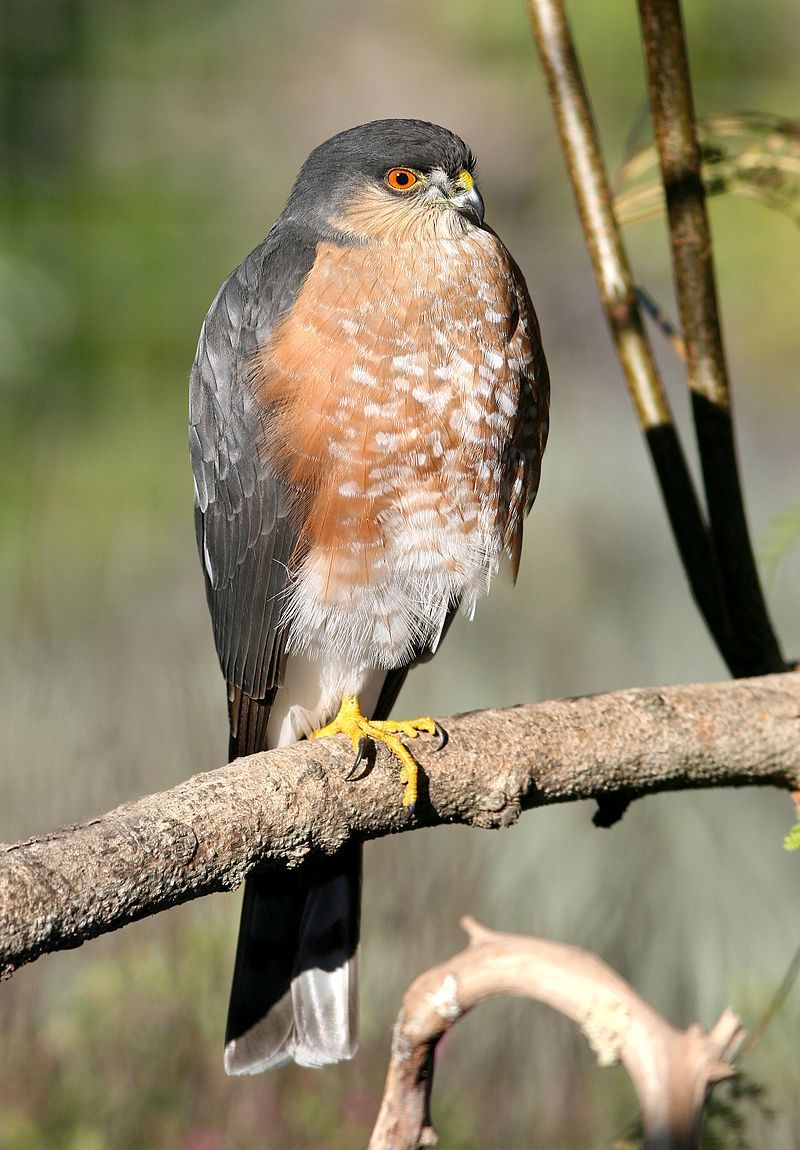
The Sharp-shinned Hawk, Accipiter striatus, is the smallest hawk in North America. This agile bird is known for its short, rounded wings and long, narrow tail, which enable maneuverability through dense forests.
Their plumage includes a blue-grey back with orange-barred underparts in adults. These hawks are adept bird hunters, often surprising their prey in a burst of speed. They are frequent visitors to backyard bird feeders, looking for an easy meal.
Sharp-skinned hawks migrate in large numbers and are known for their spectacular flight displays during migration. Their presence illustrates the complexity and excitement of avian predation dynamics in woodland ecosystems.
| Kingdom | Animalia |
| Phylum | Chordata |
| Clade | Dinosauria |
| Class | Aves |
| Order | Accipitriformes |
| Family | Accipitridae |
| Genus | Accipiter |
| Species | A. striatus |
14. Great Gray Owl (Strix nebulosa)
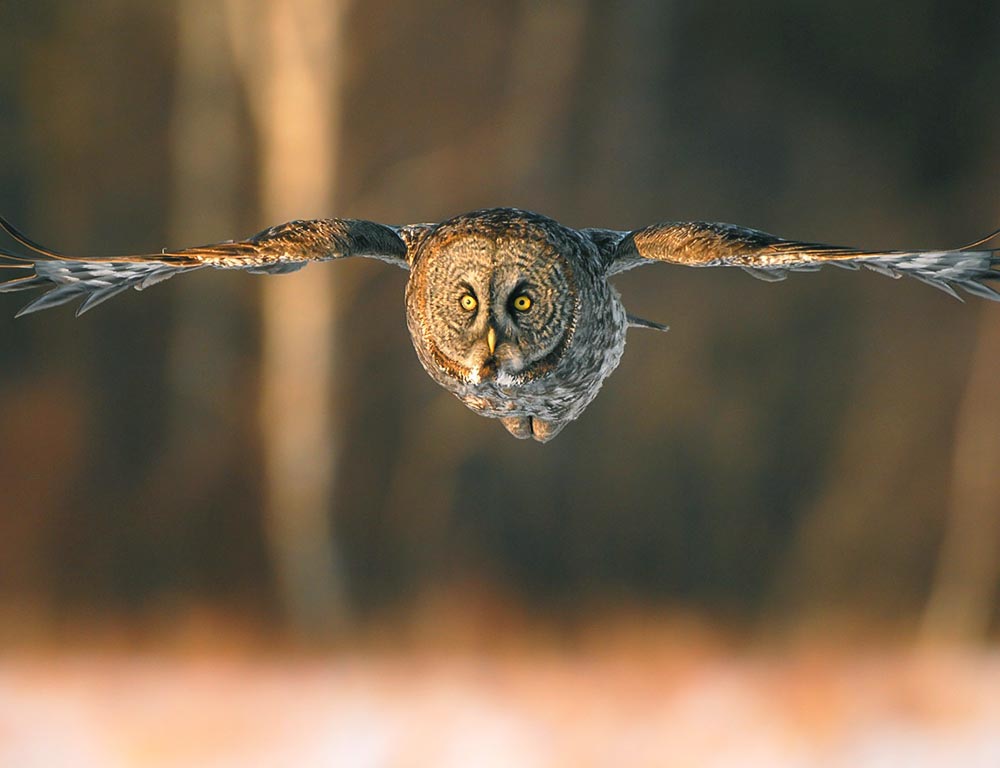
The Great Gray Owl, Strix nebulosa, is one of the largest owl species, known for its large size, rounded head, and lack of ear tufts. Despite its imposing size, it is relatively lightweight.
The plumage is a striking pattern of gray with white and brown flecks, providing excellent camouflage in its boreal forest habitat.
These owls are specialized rodent hunters, often hunting by sound in deep snow. They are mostly nocturnal but can be seen hunting during the day in the Arctic summers.
Their elusive nature and ghostly appearance make them a coveted sight for birdwatchers and a symbol of the mystique of the northern forests.
| Kingdom | Animalia |
| Phylum | Chordata |
| Clade | Dinosauria |
| Class | Aves |
| Order | Strigiformes |
| Family | Strigidae |
| Genus | Strix |
| Species | S. nebulosa |
15. Owl

| Kingdom | Animalia |
| Phylum | Chordata |
| Clade | Telluraves |
| Class | Aves |
| Order | Strigiformes |
16. Swainson’s Hawk (Buteo swainsoni)
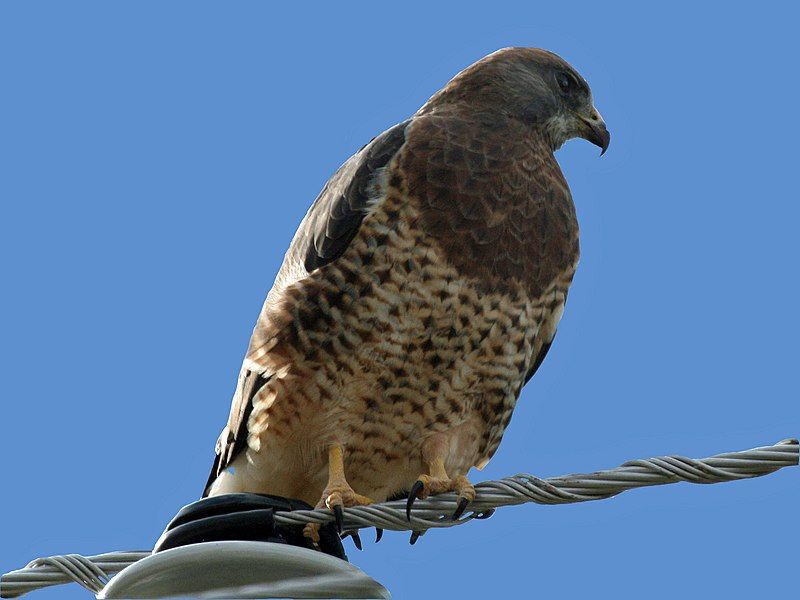
Swainson’s Hawk, Buteo swainsoni, is a long-distance migrant, traveling thousands of miles between North America and South America annually. This medium-sized raptor has a brown upper body, light underparts, and a distinctive dark bib.
Its diet is varied, including insects, small mammals, and birds. Swainson’s Hawks are often seen soaring on warm thermals or perched in open fields and prairies.
They are notable for their highly social behavior during migration, forming large flocks known as “kettles.” The migration of Swainson’s Hawks is one of the most remarkable in the raptor world, highlighting the interconnectedness of ecosystems across continents.
| Kingdom | Animalia |
| Phylum | Chordata |
| Clade | Dinosauria |
| Class | Aves |
| Order | Accipitriformes |
| Family | Accipitridae |
| Genus | Buteo |
| Species | B. swainsoni |
17. Northern Saw-whet Owl (Aegolius acadicus)
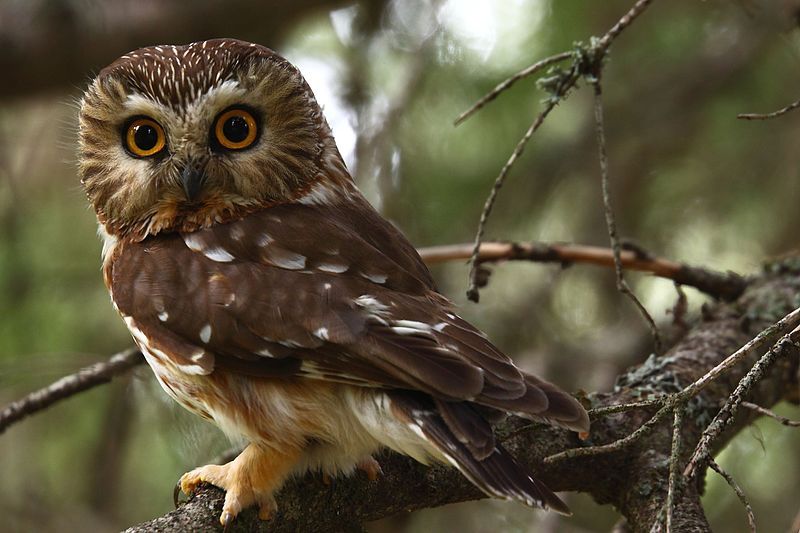
The Northern Saw-whet Owl, Aegolius acadicus, is a small and elusive owl found in North American forests.
Renowned for its “saw-whet” call, which resembles the sound of a saw being sharpened, this owl has a round, cat-like face with yellow eyes and a brown-streaked body.
Primarily nocturnal, they prey on insects and small mammals. Despite their small size, they are fierce hunters. These owls nest in tree cavities and are known for their secretive nature, making them a delightful find for bird enthusiasts.
The Northern Saw-whet Owl, with its enigmatic lifestyle and endearing appearance, captivates the imagination of those who appreciate the quieter, hidden wonders of the natural world.
| Kingdom | Animalia |
| Phylum | Chordata |
| Clade | Dinosauria |
| Class | Aves |
| Order | Strigiformes |
| Family | Strigidae |
| Genus | Aegolius |
| Species | A. acadicus |
18. Northern Goshawk (Accipiter gentilis)
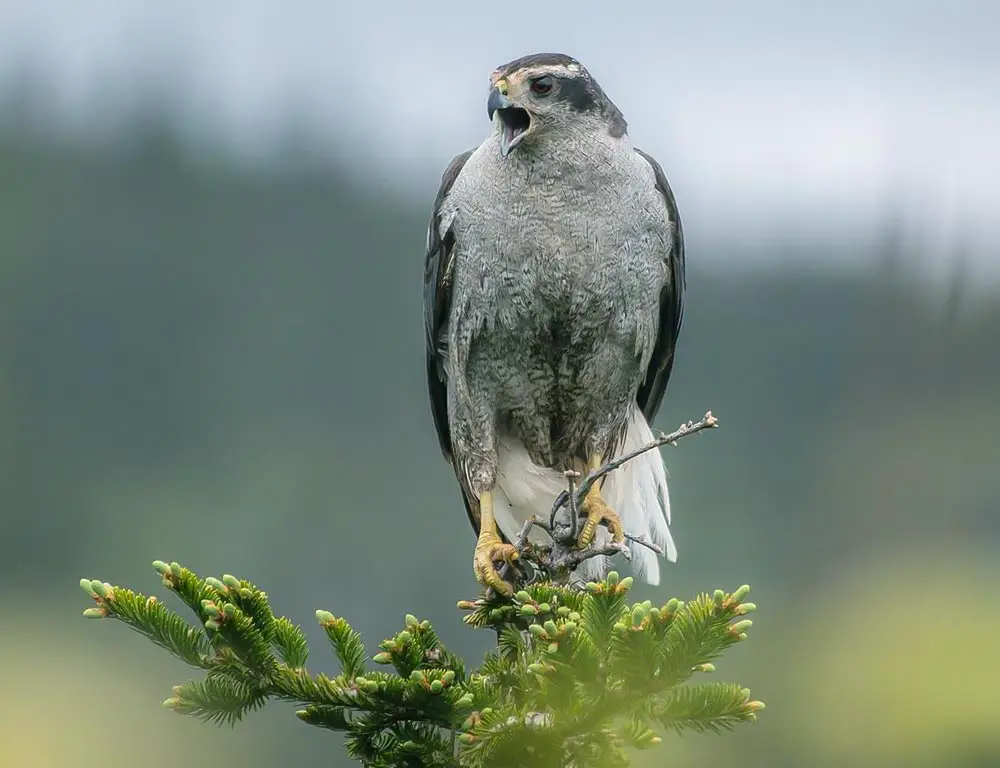
The Northern Goshawk, Accipiter gentilis, is a large, powerful raptor and the most formidable of the Accipiters. Known for its fierce hunting ability, it has short, broad wings and a long tail for agility in forested habitats.
Adults have slate-grey plumage and a striking white eyebrow stripe. They feed on a variety of prey, including birds and small mammals. Goshawks are secretive and are more often heard than seen, known for their loud, piercing calls.
They are highly territorial and are known to defend their nests fiercely. Their presence indicates a healthy, mature forest ecosystem, making them important indicators of forest health and biodiversity.
| Kingdom | Animalia |
| Phylum | Chordata |
| Clade | Dinosauria |
| Class | Aves |
| Order | Accipitriformes |
| Family | Accipitridae |
| Genus | Accipiter |
| Species | A. gentilis |
19. Prairie Falcon (Falco mexicanus)
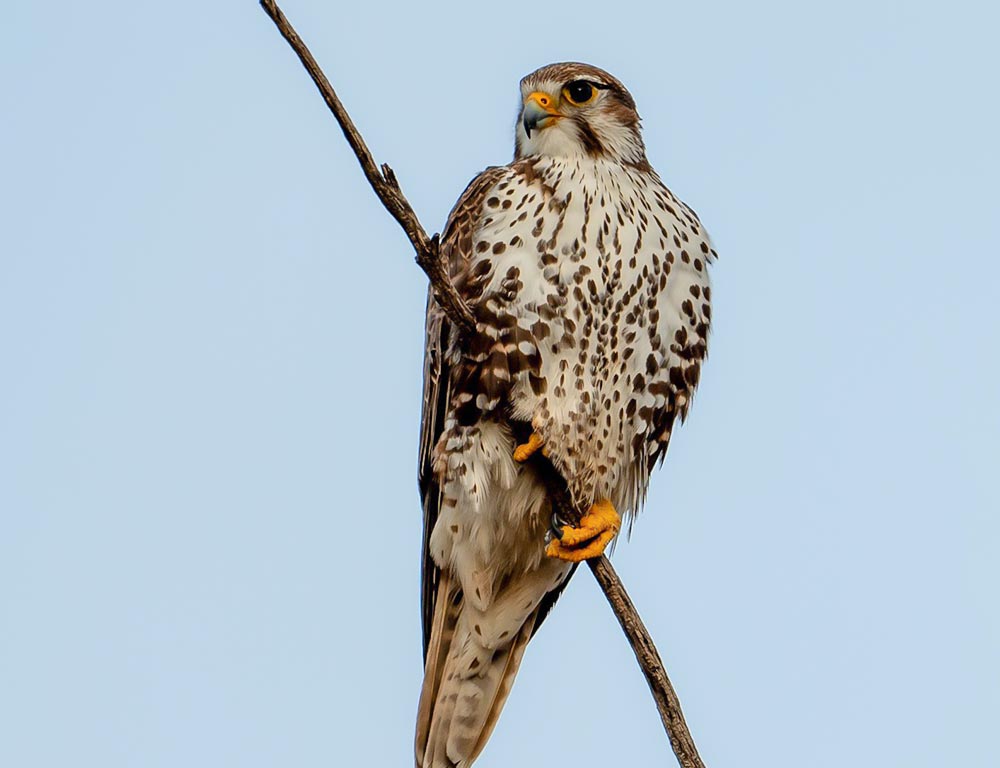
The Prairie Falcon, Falco mexicanus, is a medium-sized falcon of the American West, adapted to life in arid, open landscapes like deserts and prairies.
It resembles a small, pale version of the Peregrine Falcon, with sandy brown plumage and dark markings under the eyes.
Prairie Falcons are swift and agile in flight, preying primarily on small mammals and birds. They often nest on cliffs or in rocky outcrops.
Their presence in the prairie ecosystem highlights the diversity and adaptability of falcons. The Prairie Falcon’s speed and hunting prowess in open landscapes make it a captivating bird of prey for wildlife enthusiasts.
| Kingdom | Animalia |
| Phylum | Chordata |
| Clade | Dinosauria |
| Class | Aves |
| Order | Falconiformes |
| Family | Falconidae |
| Genus | Falco |
| Species | F. mexicanus |
20. Merlin (Falco columbarius)

The Merlin Falco columbarius is a small, fierce falcon known for its powerful flight and bold hunting behavior. They have a blue-grey back, spotted underparts, and a banded tail.
Merlins are often seen in open habitats, hunting small birds with surprising speed and agility. They adapt well to urban environments, where they can be seen hunting pigeons or other small birds.
Merlins do not build their own nests; instead, they take over abandoned nests of other bird species. Their remarkable hunting skills, even in urban settings, and their adaptability to various environments make them fascinating birds of prey.
| Kingdom | Animalia |
| Phylum | Chordata |
| Clade | Dinosauria |
| Class | Aves |
| Order | Falconiformes |
| Family | Falconidae |
| Genus | Falco |
| Species | F. columbarius |
21. Common Black Hawk (Buteogallus anthracinus)
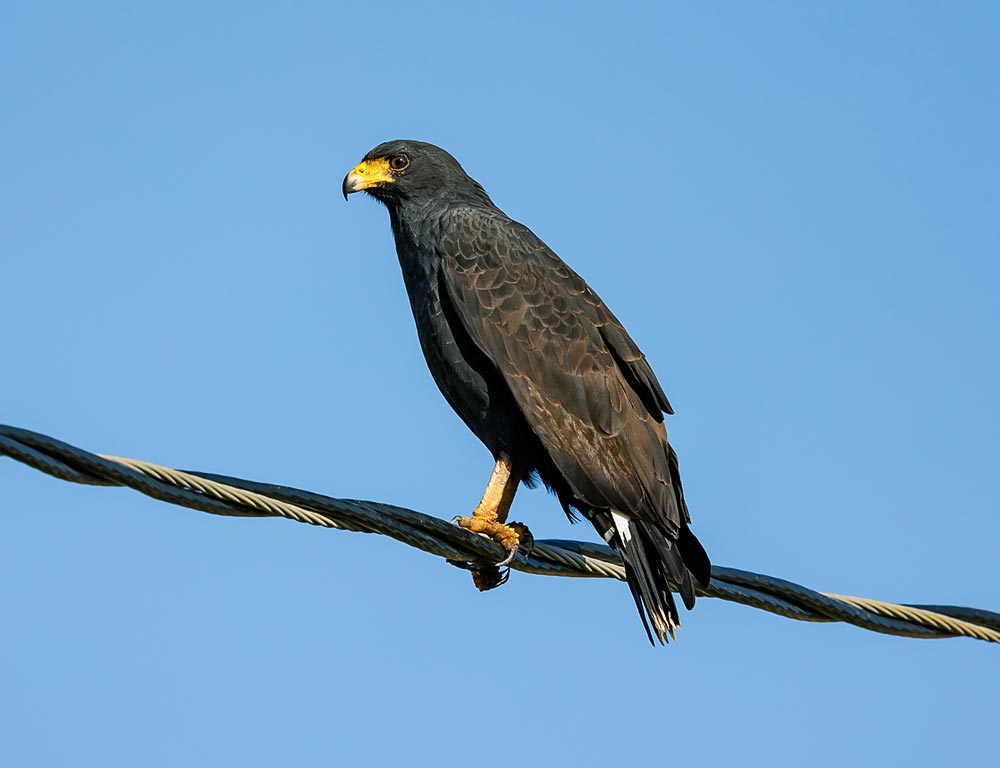
The Common Black Hawk, Buteogallus anthracinus, is a robust raptor found in parts of the southwestern United States, Central America, and South America.
It has a distinctive appearance with predominantly black plumage, a broad white tail band, and yellow legs. This hawk primarily feeds on aquatic prey like fish, frogs, and crustaceans, often seen hunting along rivers and streams.
They build large stick nests in trees near water. The Common Black Hawk’s dependence on riparian habitats makes it vulnerable to habitat loss.
Its presence is a vital indicator of the health of these ecosystems, and it plays a key role in controlling aquatic prey populations.
| Kingdom | Animalia |
| Phylum | Chordata |
| Clade | Dinosauria |
| Class | Aves |
| Order | Accipitriformes |
| Family | Accipitridae |
| Genus | Buteogallus |
| Species | B. anthracinus |
22. Turkey Vulture (Cathartes aura)
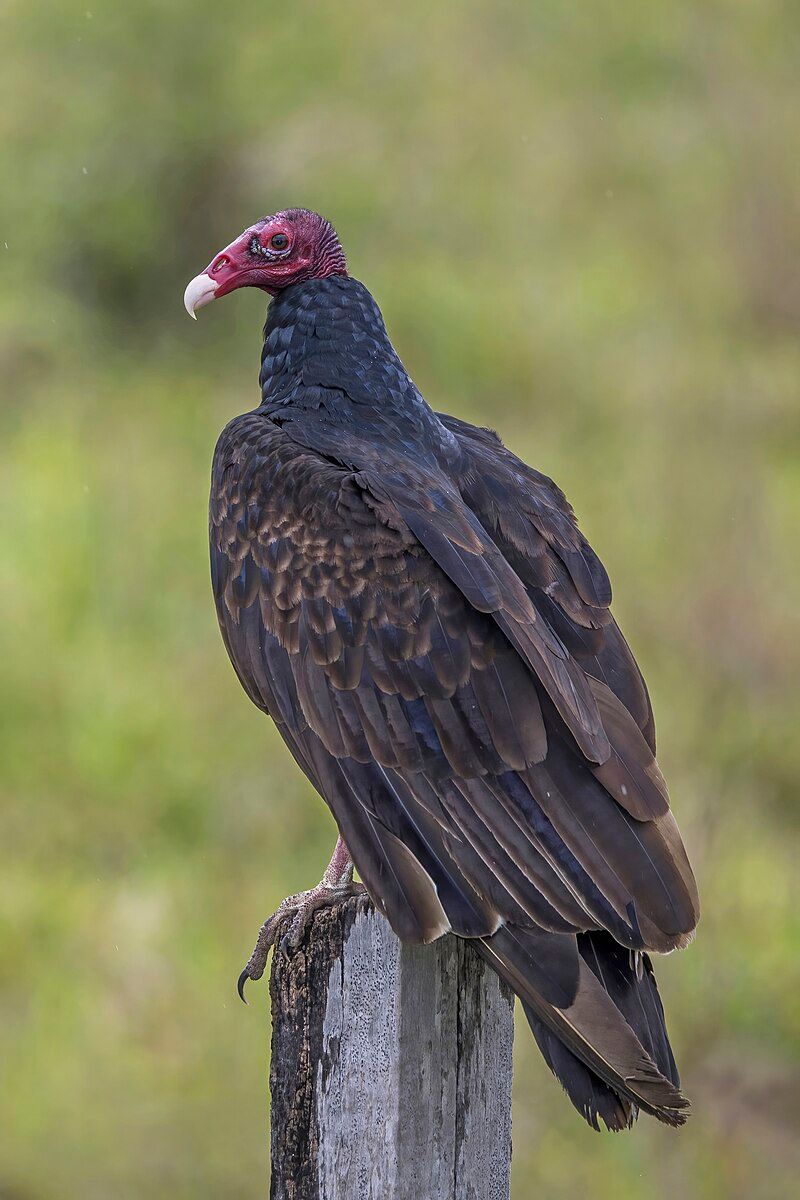
The Turkey Vulture, Cathartes aura, is a distinctive bird of prey known for its scavenging habits and remarkable soaring abilities. Recognized by its featherless red head and dark plumage, it’s a master at locating carrion with its acute sense of smell.
Often seen gliding effortlessly in large groups, Turkey Vultures play a crucial role in cleaning up carcasses, preventing the spread of disease.
They roost in trees or on cliffs and are known for their gentle disposition. Despite their somewhat unappealing diet, these vultures are ecologically vital, contributing to the decomposition process and maintaining the balance of nature’s cleanup crew.
| Kingdom | Animalia |
| Phylum | Chordata |
| Clade | Dinosauria |
| Class | Aves |
| Order | Accipitriformes |
| Family | Cathartidae |
| Genus | Cathartes |
| Species | C. aura |
23. Northern Harrier (Circus hudsonius)
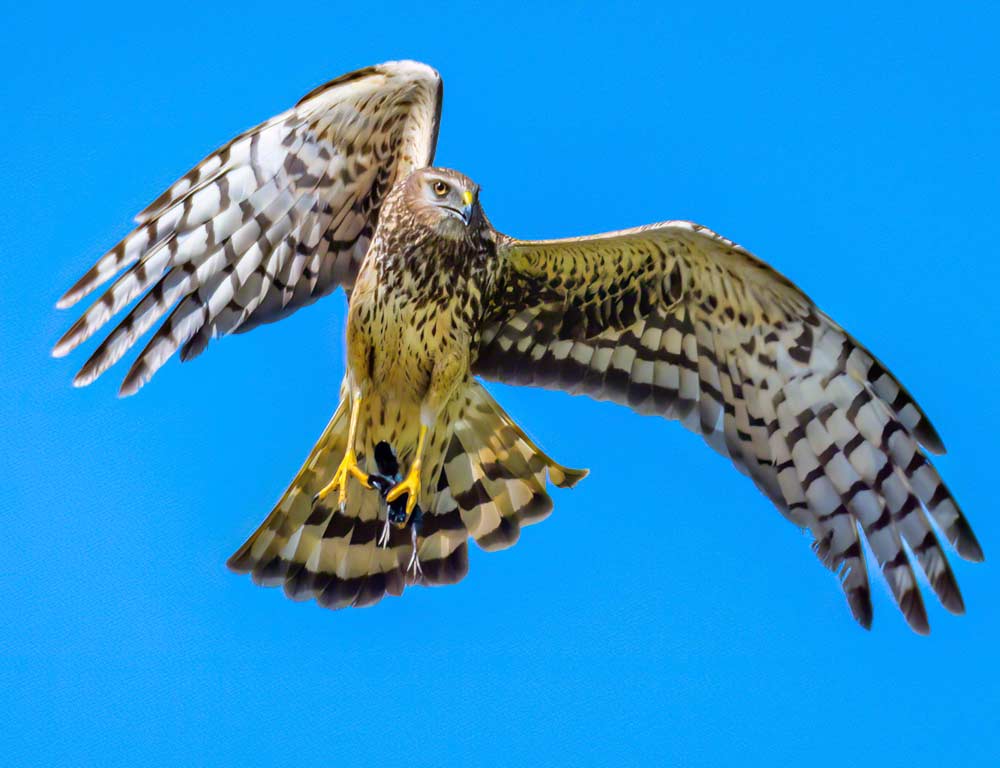
The Northern Harrier, Circus Hudsonius, is a captivating raptor with a distinctive owl-like face and unique hunting style. With a slim body, long wings, and a long tail, it hunts by flying low over open fields and marshes.
Known for its keen hearing and sight, it primarily preys on small mammals and birds. The facial disk funnels sound to its ears, resembling owls.
Northern Harriers are ground nesters, often seen in open, grassy habitats. Their population serves as an indicator of the health of these ecosystems.
Their unique hunting method and adaptation to diverse landscapes make them a fascinating species in the raptor family.
| Kingdom | Animalia |
| Phylum | Chordata |
| Clade | Dinosauria |
| Class | Aves |
| Order | Accipitriformes |
| Family | Accipitridae |
| Genus | Circus |
| Species | C. hudsonius |
24. Zone-tailed Hawk (Buteo albonotatus)
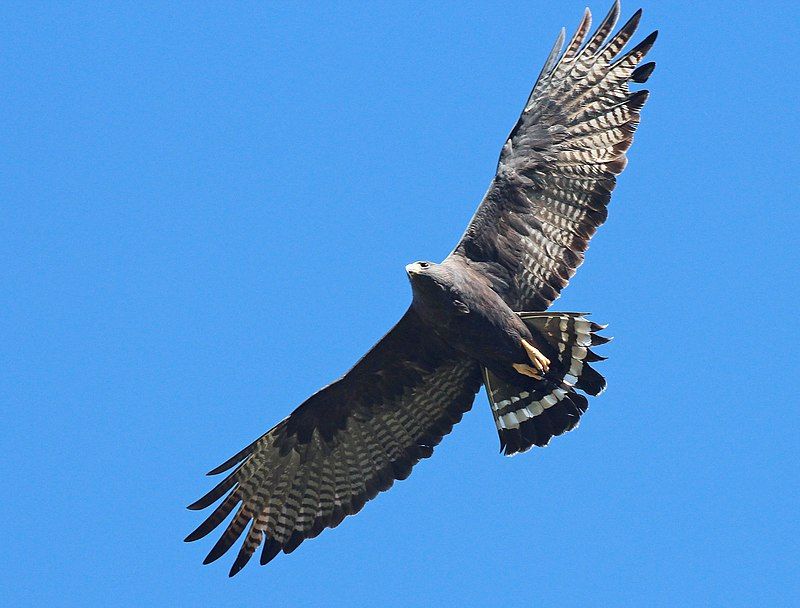
The Zone-tailed Hawk, Buteo albonotatus, is a stealthy raptor found in the western United States and parts of Central and South America. It has plumage that mimics that of Turkey Vultures, featuring black and white markings.
This mimicry allows it to approach prey more easily, as potential prey may mistake it for a non-threatening vulture. Zone-tailed Hawks primarily feed on small mammals and birds.
They are often seen soaring in warm air currents and are known for their skillful aerial displays. Despite their striking appearance, they maintain an element of surprise in their hunting strategy, making them an intriguing member of Utah’s raptor community.
| Kingdom | Animalia |
| Phylum | Chordata |
| Clade | Dinosauria |
| Class | Aves |
| Order | Accipitriformes |
| Family | Accipitridae |
| Genus | Buteo |
| Species | B. albonotatus |
Conclusion
Utah’s varied landscapes are a testament to the adaptability and diversity of its birds of prey. Each species contributes uniquely to the ecosystem, from high-flying eagles to stealthy owls, demonstrating nature’s intricate balance.
Observing these raptors in Utah offers a glimpse into their fascinating behaviors and survival strategies and underscores the importance of conserving their habitats.
Their presence is a barometer of environmental health, and their survival is intertwined with the well-being of our natural world.
As such, these birds of prey are not just residents of Utah’s skies but are integral parts of its natural heritage and biodiversity.